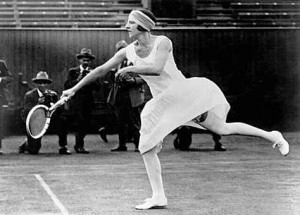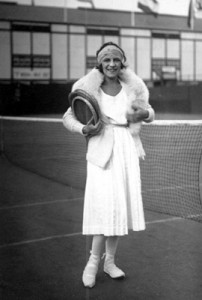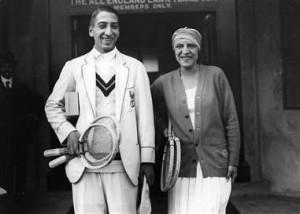Queens of the Court: Suzanne Lenglen, An Original Diva

Suzanne Lenglen won 12 Grand Slam titles.
She was called ‘La Divine.’ Some say in the 1920s Suzanne Lenglen was a bigger name in sports than that of Babe Ruth.
Between 1919 and 1926, at a time when three and not four tennis majors were played, she won twelve Grand Slam titles, on three different surfaces, and an Olympic Gold medal (Antwerp). Notably in seven of 81 singles titles she did not lose a game!
She was dominant in a way that only a handful of male stars have been since the open era of tennis. More than that, she imposed her personality on the sport, and the entertainment world of the day. We recognize such a personality in contemporary terms, in modern English, we might call her a diva.

Lenglen paved the way for the "Divas" of today.
Diva: A talented, imperious, and overly dramatic female performer.
Her command of the media, the crowds of fans drawn to her tennis, but more so because of her immense celebrity, are comparable to divas of contemporary screen and stage. (Here’s a clip of contemporary divas Whitney Houston and Maria Carey going at it).
On Bleacher Report we have a long running argument about whether women should receive the same pay as men for their contributions to the game of tennis. As an example of the enormous draw-power of Ladies’ tennis, Wimbledon, in 1922, decided to move the tennis center from Worple Road to its larger, current location on Church Road, in order to accommodate the following of of a single tennis star. None of the male stars of the age commanded such a show of respect. Wimbledon was moved because of Suzanne Lenglen.
Forma Divina:
Most famous for leaping into the air to strike a ball, as shown in the picture that opens this piece, Lenglen was able to create a stunning forehand by leaning into it, and was devastatingly accurate with her first serve. Her accuracy was honed by her coach and father, who used to put a handkerchief down on the court at random to provide a target. She is reported to have had remarkable anticipation and a complete, all-court game. But it was the fact that she played unencumbered by the tight layers of clothing that others wore that also made a contribution to her extraordinary success.
Flappers, The Charleston, and Women in the 1920s:
In Paris Lenglen’s contemporary, Coco Chanel, working in the (otherwise entirely male) world of clothing design, introduced a stunning concept – women’s sportswear – at her Paris showroom in 1913. It was only a year later that Lenglen was to begin making her mark in the world of tennis (1914).

Lenglen and Rene Lacoste were among the top tennis stars of the 1920s.
Chanel struggled to redefine a woman’s ‘image’; to depart from the clothing structures of the Victorian era. Chanel wanted to introduce “a sense of freedom”. She wanted a complete separation from lace, corsets, underclothes, and padding which she felt separated women from their bodies.
A new breed of self-confident young women would be drawn to Chanel’s iconic style, a style that is indelibly associated with the image of the 1920s ‘flapper.’ Flappers demonstrated their independence by wearing short skirts and haircuts, openly using cosmetics, and being seen to smoke and drink cocktails.
Flappers exhibited an increased level of activity over their Victorian forebears, driving their own automobiles, and going out to nightclubs where they could listen to jazz, pursuing athletic sports or energetic dances such as the Charleston.
D-delightful; I-invasive; V-vivacious; A-attitude.
Ms. Lenglen entered right into the flapper spirit. Though not particularly attractive from a physical point of view ( she had the looks of ‘Lyndon Johnson in drag’ according to a contemporary blogger), she dressed and wore for competition, shorter, flowing skirts, that allowed her legs freedom of movement (and showed them off, of course).
Thus she was able to tap her considerable athletic talents and demonstrate in dramatic fashion, a different aspect of femininity that had been rejected in the Victorian era.
Like male contemporary tennis stars, Ms. Lenglen was known for screaming at referees over bad line calls – a true departure from the demure standard of the previous era and likely contributing to her reputation for temperamental flair. She also was known for pouting on court and even weeping – actions that were recognized at the time as passion for the game.
1926: Divine Cusp between a Golden Age and the Contemporary World :
1926, the year of the ‘Match of the Century,’ discussed below, was a year that saw the birth of Norma Jeane Mortenson who would become the quintessential icon of celebrity and power over the media (Marylin Monroe), to whom Ms. Lenglen can be compared at least in terms of stature in the media.
1926 saw the production of a movie by Al Jolson that would enable The Jazz Singer (the first talking movie) to be made the following year – breaking open the field of entertainment.
1926 also saw the publication of a landmark novel by mystery writer Agatha Christie (later Dame Agatha Christie), who’s volume of sales of published works currently is only eclipsed by that of The Bible.
In this masterpiece, The Murder of Roger Ackroyd , Ms. Christie breathtakingly broke established conventions about storytelling (which can’t be revealed here, obviously, without introducing a spoiler), putting her on a par with analytical male writers such as Edgar Allan Poe and Arthur Conan Doyle.

Lenglen and Helen Wills (right) were rivals during the 1920s.
Roll ‘em:
This video captures all that was magnificent about Suzanne Lenglen, why she is such a legend of the sport, and why we still celebrate her achievements to this day. In the video you will see the elements of her that we have presented thus far: power over the media, imposing herself on a match, shocking attire that presaged contemporary sportswear, incredible forehands, feel at the net, and power serving that pre-dates the contemporary women’s game.
It is the ‘Match of the Century’ from 1926 – between the indomitable international superstar Suzanne Lenglen and the uncomplicated California ingénue, Helen Wills.
Things to watch for:
In this video you’ll see Lenglen entering the stadium like a Hollywood movie star—only Hollywood as we know it today did not yet exist. Keeps Wills waiting (like anyone we know from contemporary tennis?) while she signs autographs. Drinks on a changeover from a flask of brandy! The number of spectators (3000) was large for a tennis match in that locale (Cannes, France), and swarmed all over the court. The block of photographers seems about the same size as it would be in a contemporary major. At the end, about 6-8 huge bouquets are brought out, presumably for Ms. Lenglen, since it doesn’t look like anything is brought for Helen Wills.
The body language as both women come out is classic. Lenglen strides around the court, shoulders back, and head up. Wills schlepps to her side like a teenager doing a chore (she was a teenager at the time). Both women are wearing short(er) skirts. Helen Willis is actually wearing a visor. One of them has a wicked backhand. Both seem to move pretty fast around the court, and Lenglen looks to have a very nice slice backhand.
Lenglen’s life in brief :
She was born in 1899. Sickly, she took up tennis at the encouragement of her father, to bolster her health. She perished at an early age (37) to leukemia. She played her first Slam at age 14 in 1914. She was the first female World #1, when rankings were introduced in 1921 and she is sometimes credited with singlehandedly turning tennis from a country club sport without much public attention into a nation’s (France) biggest sporting draw at the time. Such was her mark on the sport that 1997 saw the dedication of the second show court at Roland Garros—site of the second tennis major played every year t—to La Divine Suzanne Lenglen.
Summary :
- Lenglen: 12 Grand Slam singles Titles; 1920 gold medal
- BJK: 12 Grand Slam singles Titles
- Navratilova: 18 Grand Slam singles Titles
- Evert: 18 Grand Slam singles Titles
- Wills: 19 Grand Slam singles Titles (all surfaces); 1924 gold medal
- Graf: 22 Grand Slam singles Titles (all surfaces in a single year); 1988 gold medal
- Court: 24 Grand Slam singles Titles
Read other articles in this series about women and their contributions to the game, see how 18th century American Molla Mallory pioneered the‘look of flowing short skirts for Ladies’ tennis, how Helen Willis came of age as an American rival of Suzanne Lenglen. Look for other articles about Billie Jean King (BJK), Martina Navratilova, among others.
For more in the “Queens of the Court” series check out:
- Molla Mallory
- Helen Wills
- Suzanne Lenglen
- Althea Gibson
- Maureen Connolly
- Evonne Goolagong
- Billie Jean King
- Maria Bueno
- Margaret Court
- Steffi Graf
- Chris Evert
- Martina Navratilova
- Monica Seles
Claudia Alexander is a regular tennis contributor for Bleacher Report and has graciously allowed her work in the “Queens of the Court” series to appear on Sports Then and Now.
Good job, i dont know what to say except that I have enjoyed reading. Are there any forums that you recommend I join ?
Good job, i’m glad you’re enjoying it. I should just give up and take lessons from you
Praises for this article, I will append this site to my bookmark, my acquaintance just stated to me about this just last week. Thanks again
Dang
I just spent ages typing a long comment, but when I tried to submit it my Internet Explorer hung.
Was it somehow saved or should I retype it all again?
I’m happy I found this weblog, I couldnt uncover any data on this subject matter prior to. I also run a site and if you want to ever serious in a little bit of guest writing for me if possible really feel free to let me know, i’m always look for people to test out my site. Please stop by and leave a comment sometime!
While I truly like this publish, I think there was an spelling error near towards the end from the 3rd section.
Not to hijack this thread, but I’d like to find out if I’m eligible for a short sale and I can’t figure out how to find a local, highly regarded realtor… do you have any info on this realtor? They’re listed in the city of sacramento, 15 minutes from me and I can’t find reviews on them – Becky Lund & Associates – Sacramento Realtors, 8814 Madison Avenue #2 Fair Oaks, CA 95628 (916) 531-7124
I am regular visitor, how are you everybody? This piece
of writing posted at this website is really good.
Men’s Minnesota Vikings Pro Line Purple Mallory Adjustable Hat,Pittsburgh Steelers Infant TD 3-Pack Creeper Set – White/Gold/Black wholesale jerseys for women Atlanta Falcons Custom Jersey https://www.jerseyshop.cn/san-francisco-49ers-c-1… Toddler Jacksonville Jaguars Nike Black Customized Game Jersey Patriots Jerseys Wholesale nfl cheap jerseys uk cheap nfl lanyards 4 u
. Her accuracy was honed by her coach and father, who used to put a handkerchief down on the court at random to provide a target. She is reported to have had remarkable anticipation and a complete, all-court game. But it was the fact that she played unencumbered by the tight layers of clothing that others wore that also made a contribution to her extraordinary success,Great,thank you so much for this tips
is coconut oil good for hair
Good submit.. primary Spanish I’m checking regularly this kind of weblog using this program . empowered! Very helpful data specifically the ultimate part 🙂 I actually manage this sort of details a great deal. I had been looking for that certain details for the quite a while. Thanks plus enjoy.